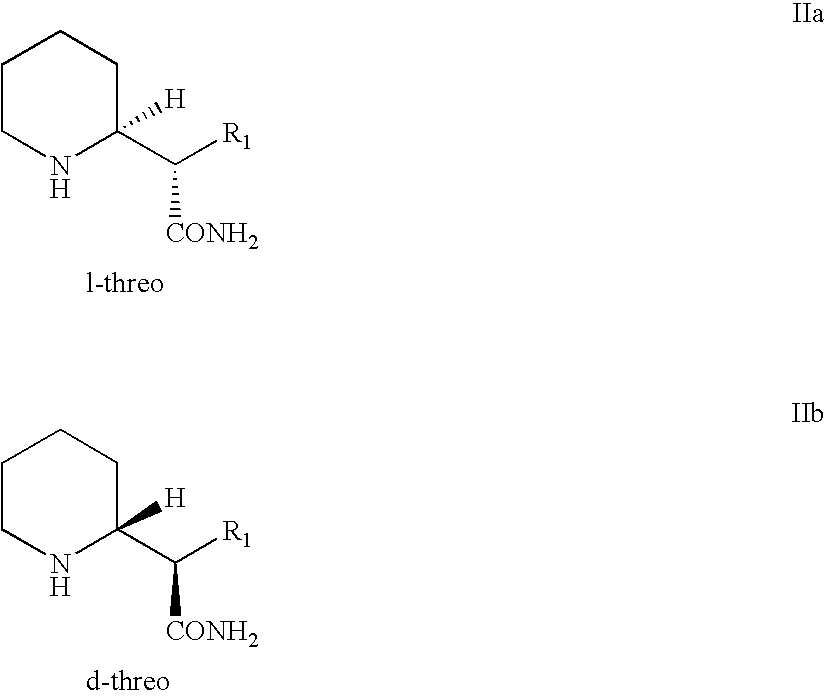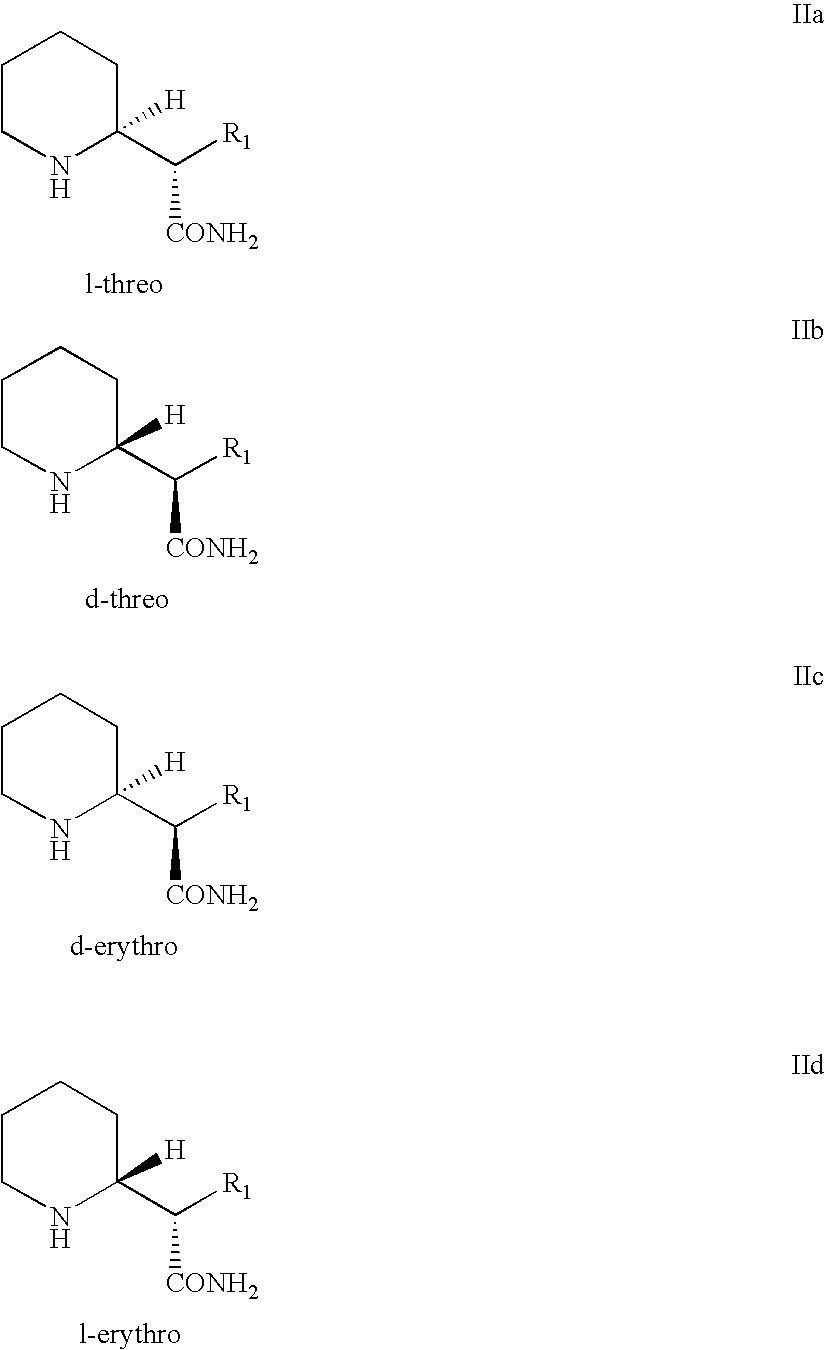Process and intermediates for resolving piperidyl acetamide steroisomers
a technology of piperidyl acetamide and stereoisomers, which is applied in the field of process and intermediates for resolving piperidyl acetamide stereoisomers, can solve the problems of affecting the purity of the mixture of such drugs, notable side effects, and affecting the purity of the mixture, and achieves high optical purity
- Summary
- Abstract
- Description
- Claims
- Application Information
AI Technical Summary
Benefits of technology
Problems solved by technology
Method used
Image
Examples
example 1
Preparation of d-Threo-methylphenidate Hydrochloride Via Diastereomeric Separation and Resolution of d,l-erythro-Amide (Comparative Example)
[0023]A. α-Phenyl-α-pyridyl-(2)-acetonitrile
[0024]
Materials:2-Chloropyridine (99%)286 g (2.50 moles)Benzyl cyanide (98%)314 g (2.62 moles)Sodium amide (90%)217 g (5.00 moles)Toluene0.98 + 0.17 LWater0.87 LEthyl acetate0.43 LHexanes1.56 + 1.95 LBrine0.43 L
Procedure
[0025]A 5 L multi-neck glass reactor was charged with 2-chloropyridine, benzyl cyanide, and toluene (0.98 L). Sodium amide powder was added over a 1 h period via a solid-addition funnel, keeping the reaction temperature below 30° C. The reaction mixture was stirred for 16 h at ambient temperature. The reaction was then cooled to ˜10° C., and quenched with 0.87 L water. Ethyl acetate (0.43 L) was added to solubilize the precipitated product. The organic layer was separated and washed once with 0.43 L brine. Solvent was removed from the organic layer on a rotovap, and toluene (0.17 L), fo...
example 2
Preparation of d-Threo-methylphenidate Hydrochloride Via Epimerization and Resolution of d,l-Threo-amide Enantiomers
[0043]A. α-Phenyl-α-pyridyl-2-acetonitrile
[0044]
Materials:2-Chloropyridine (99%)172 g (1.50 moles)Benzyl cyanide (98%)188 g (1.576 moles)Sodium amide (90%)130 g (3.00 moles)Toluene0.59 + 0.10 LWater0.52 LEthyl acetate0.26 LHexanes0.94 + 1.17 LBrine0.26 L
Procedure
[0045]The reactor was charged with 2-chloropyridine, benzyl cyanide, and toluene (0.59 L). Sodium amide powder was added over a 1 h period via a solid-addition funnel, keeping the reaction temperature below 300° C. The reaction mixture was stirred for 16 h at ambient temperature. The reaction was cooled to ˜10° C., and quenched with 0.52 L water. Ethyl acetate (0.26 L) was added to solubilize the precipitated product. The organic layer was separated and washed once with 0.26 L brine, and solvent was removed from the organic layer on a rotovap. Toluene (0.10 L), followed by hexanes (0.94 L) were added to the res...
example 3
Preparation of l-Threo-methylphenidate Hydrochloride Via Epimerization and Resolution of d,l-Threo-amide Enantiomers
[0062]A. α-Phenyl-α-pyridyl-2-acetonitrile
[0063]
Materials:2-Chloropyridine (99%)172 g (1.50 moles)Benzyl cyanide (98%)188 g (1.576 moles)Sodium amide (90%)130 g (3.00 moles)Toluene0.59 + 0.10 LWater0.52 LEthyl acetate0.26 LHexanes0.94 + 1.17 LBrine0.26 L
Procedure
[0064]The reactor was charged with 2-chloropyridine, benzyl cyanide, and toluene (0.59 L). Sodium amide powder was added over a 1 h period via a solid-addition funnel, keeping the reaction temperature below 300° C. The reaction mixture was stirred for 16 h at ambient temperature. The reaction was cooled to ˜10° C., and quenched with 0.52 L water. Ethyl acetate (0.26 L) was added to solubilize the precipitated product. The organic layer was separated and washed once with 0.26 L brine, and solvent was removed from the organic layer on a rotovap. Toluene (0.10 L), followed by hexanes (0.94 L) were added to the res...
PUM
| Property | Measurement | Unit |
|---|---|---|
| temperature | aaaaa | aaaaa |
| temperature | aaaaa | aaaaa |
| temperature | aaaaa | aaaaa |
Abstract
Description
Claims
Application Information
 Login to View More
Login to View More - R&D
- Intellectual Property
- Life Sciences
- Materials
- Tech Scout
- Unparalleled Data Quality
- Higher Quality Content
- 60% Fewer Hallucinations
Browse by: Latest US Patents, China's latest patents, Technical Efficacy Thesaurus, Application Domain, Technology Topic, Popular Technical Reports.
© 2025 PatSnap. All rights reserved.Legal|Privacy policy|Modern Slavery Act Transparency Statement|Sitemap|About US| Contact US: help@patsnap.com



